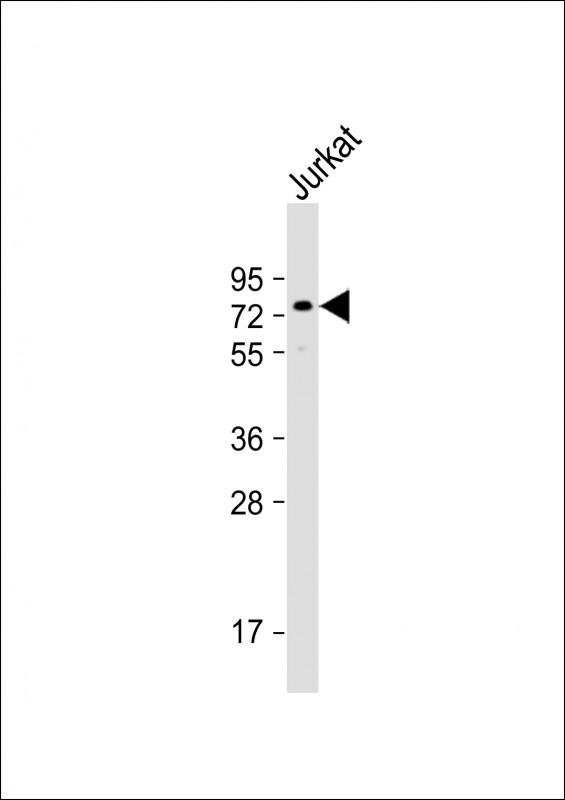CPSF6 Antibody (N-term)
Affinity Purified Rabbit Polyclonal Antibody (Pab)
- 产品详情
- 实验流程
- 背景知识
Application
| WB, E |
|---|---|
| Primary Accession | Q16630 |
| Other Accession | Q6DDW4, Q6NVF9, Q6NWC6, Q5ZL34, Q0P5D2, NP_008938.2 |
| Reactivity | Human |
| Predicted | Bovine, Chicken, Zebrafish, Mouse, Xenopus |
| Host | Rabbit |
| Clonality | Polyclonal |
| Isotype | Rabbit IgG |
| Calculated MW | 59210 Da |
| Antigen Region | 23-51 aa |
| Gene ID | 11052 |
|---|---|
| Other Names | Cleavage and polyadenylation specificity factor subunit 6, Cleavage and polyadenylation specificity factor 68 kDa subunit, CFIm68, CPSF 68 kDa subunit, Pre-mRNA cleavage factor Im 68 kDa subunit, Protein HPBRII-4/7, CPSF6, CFIM68 |
| Target/Specificity | This CPSF6 antibody is generated from rabbits immunized with a KLH conjugated synthetic peptide between 23-51 amino acids from the N-terminal region of human CPSF6. |
| Dilution | WB~~1:1000 E~~Use at an assay dependent concentration. |
| Format | Purified polyclonal antibody supplied in PBS with 0.09% (W/V) sodium azide. This antibody is purified through a protein A column, followed by peptide affinity purification. |
| Storage | Maintain refrigerated at 2-8°C for up to 2 weeks. For long term storage store at -20°C in small aliquots to prevent freeze-thaw cycles. |
| Precautions | CPSF6 Antibody (N-term) is for research use only and not for use in diagnostic or therapeutic procedures. |
| Name | CPSF6 (HGNC:13871) |
|---|---|
| Function | Component of the cleavage factor Im (CFIm) complex that functions as an activator of the pre-mRNA 3'-end cleavage and polyadenylation processing required for the maturation of pre-mRNA into functional mRNAs (PubMed:14690600, PubMed:29276085, PubMed:8626397, PubMed:9659921). CFIm contributes to the recruitment of multiprotein complexes on specific sequences on the pre-mRNA 3'-end, so called cleavage and polyadenylation signals (pA signals) (PubMed:14690600, PubMed:8626397, PubMed:9659921). Most pre-mRNAs contain multiple pA signals, resulting in alternative cleavage and polyadenylation (APA) producing mRNAs with variable 3'-end formation (PubMed:23187700, PubMed:29276085). The CFIm complex acts as a key regulator of cleavage and polyadenylation site choice during APA through its binding to 5'- UGUA-3' elements localized in the 3'-untranslated region (UTR) for a huge number of pre-mRNAs (PubMed:20695905, PubMed:29276085). CPSF6 enhances NUDT21/CPSF5 binding to 5'-UGUA-3' elements localized upstream of pA signals and promotes RNA looping, and hence activates directly the mRNA 3'-processing machinery (PubMed:15169763, PubMed:21295486, PubMed:29276085). Plays a role in mRNA export (PubMed:19864460). |
| Cellular Location | Nucleus. Nucleus, nucleoplasm. Nucleus speckle. Cytoplasm. Note=Shuttles between the nucleus and the cytoplasm in a transcription- and XPO1/CRM1-independent manner, most probably in complex with the cleavage factor Im complex (CFIm) (PubMed:19864460). Colocalizes with PSPC1 in punctate subnuclear structures often located adjacent to nuclear speckles, called paraspeckles, and corresponding to interchromatin granules-associated zones (IGAZs) (PubMed:17267687). Distribution in speckles and paraspeckles varies during the cell cycle (PubMed:17267687). Associates at sites of active transcription on nascent perichromatin fibrils (PFs) and perichromatin granules (PubMed:17267687). Nuclear import is mediated via interaction with TNPO3 independently of CPSF6 phosphorylation status (PubMed:30916345). |
For Research Use Only. Not For Use In Diagnostic Procedures.
Provided below are standard protocols that you may find useful for product applications.
BACKGROUND
The protein encoded by this gene is one subunit of a cleavage factor required for 3' RNA cleavage and polyadenylation processing. The interaction of the protein with the RNA is one of the earliest steps in the assembly of the 3' end processing complex and facilitates the recruitment of other processing factors. The cleavage factor complex is composed of four polypeptides. This gene encodes the 68kD subunit. It has a domain organization reminiscent of spliceosomal proteins.
REFERENCES
Lee, K., et al. Cell Host Microbe 7(3):221-233(2010)
Ruepp, M.D., et al. Mol. Biol. Cell 20(24):5211-5223(2009)
Xin, X., et al. Genome Res. 19(7):1262-1269(2009)
Maggi, L.B. Jr., et al. Mol. Cell. Biol. 28(23):7050-7065(2008)
Gudbjartsson, D.F., et al. Nat. Genet. 40(5):609-615(2008)
终于等到您。ABCEPTA(百远生物)抗体产品。
点击下方“我要评价 ”按钮提交您的反馈信息,您的反馈和评价是我们最宝贵的财富之一,
我们将在1-3个工作日内处理您的反馈信息。
如有疑问,联系:0512-88856768 tech-china@abcepta.com.























 癌症的基本特征包括细胞增殖、血管生成、迁移、凋亡逃避机制和细胞永生等。找到癌症发生过程中这些通路的关键标记物和对应的抗体用于检测至关重要。
癌症的基本特征包括细胞增殖、血管生成、迁移、凋亡逃避机制和细胞永生等。找到癌症发生过程中这些通路的关键标记物和对应的抗体用于检测至关重要。 为您推荐一个泛素化位点预测神器——泛素化分析工具,可以为您的蛋白的泛素化位点作出预测和评分。
为您推荐一个泛素化位点预测神器——泛素化分析工具,可以为您的蛋白的泛素化位点作出预测和评分。 细胞自噬受体图形绘图工具为你的蛋白的细胞受体结合位点作出预测和评分,识别结合到自噬通路中的蛋白是非常重要的,便于让我们理解自噬在正常生理、病理过程中的作用,如发育、细胞分化、神经退化性疾病、压力条件下、感染和癌症。
细胞自噬受体图形绘图工具为你的蛋白的细胞受体结合位点作出预测和评分,识别结合到自噬通路中的蛋白是非常重要的,便于让我们理解自噬在正常生理、病理过程中的作用,如发育、细胞分化、神经退化性疾病、压力条件下、感染和癌症。







